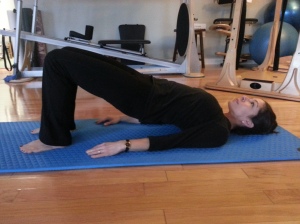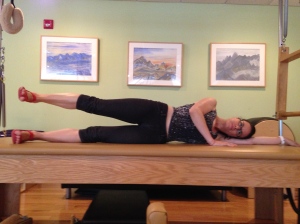Lately I’ve been fascinated by the gluteal muscles, possibly due to a Gyrotonic® principal, “wrapping of the sacrum”, which clinically I have seen help multiple people with SI joint and low back pain or possible due to my gradual decline in the posterior perkiness of my behind as I sit more and more in the massive Washington DC traffic. However, I would like to believe my fascination is due to a rare gradual anterior hip subluxation in one of my patients and a unique weakness in internal rotation and abduction without external hip weakness in another patient, her compensations were quite remarkable prior to treatment. Whatever the inspiration here are some thoughts on the behind and how it should lead us through life.
While we explore the amazing orchestra of the human body, we cant ignore the components of the deep fascial structures, the neural tissue and the vascular supply that are interwoven through out the muscles and bones however as I’ve been told many times “keep it simple stupid.” Thus, I will do my best to focus on the major muscles of the hips and leave out some of the structures around the hip. Please note, I do realize this is like having an orchestra of drums and violins and leaving out the flutes and harps.
Altered mechanics and firing of the gluteal muscles around the hip have been shown in people with chronic low back, hip pain, knee pain (altered patella tracking, increased risk of ACL tears) and even ankle sprains. Much like the rotator cuff of the shoulder/ humeral head, the gluteus muscles help to stabilize the femur in the hip socket. Gluteal stretching, tissue mobility and strengthening is an important part of any spine and lower extremity rehab program. In order to fix these mechanics lets start with a short review of the anatomy and function of the muscles:
The major superficial muscles of the hip are:
1) Gluteus Maximus –primarily a powerful hip extension, attaches from iliac crest down to top 1/3 of femur (not just to the gluteal fold, down the leg!), antagonist to psoas
2) Gluteus Medius – hip abduction (pelvic stabilization in gait) and internal rotator
3) Gluteus Minimus – hip abduction and internal rotation (similar to medius)
4) Tensor Fascia Late – hip abduction and internal rotation and knee stabilization and pelvic stabilization in gait
When the leg is up in the air (not attached to the ground) abduction will look like this…
Note the waist will be off the floor with proper abduction, if the waist is on the floor then this is spine bending not leg lifting. Keep in mind average hip abduction range is 30-50 degrees, you will not be able to kick very high
When standing on the leg abduction will keep the pelvis neutral. In the photo below the left hip abductors are working to keep the pelvis level….
not like this (aka “model walk” or “Trendelenberg gait”), with the right hip dropped and the left leg in relative adduction…
The 6 deep muscles of the hip are:
1) Piriformis (acts as an internal rotator in flexion/sitting, external rotator in extension/standing)
2) Gemellus superior and 3) Gemellus inferior
4) Obturator Internus and 5) Obturator externus
6) Quadratus Femoris
The above 6 muscles turn the thigh bone, femur, out in the hip socket, acetabulum, (lateral or external rotation) and with the tendons, labrum and ligaments help stabilize the femur. They have been referred to as “the rotator cuff of the hip” (you may have heard of rotator cuff injuries in the shoulder). Our feet naturally strike the ground at about 15 degrees of external rotation or “toe out” (norms range from 7 to 25 degrees) thus these deep lateral rotators are extremely important in supporting the thigh bone in gait and may even prevent osteoarthritis in the knee (4).
So that’s 10 muscles on each cheek!
Now that the anatomy lesson is done…
Here are Favorite floor hip Exercises:
Supine/ lying on back
1a) Bridges double (with two feet on floor)
or
1b) Single leg variation (with one foot on floor and one in air) for hip extension
a glute max pick me up.

Keep knees in line with feet. Start by pressing feet into floor, roll shoulders back, lift hips. Feel the knees reaching away so there is no compression in low back. Make sure to activate the gluteals! If 10 reps feels easy, try lifting one leg and do 10 bridges on each side.
2) Figure 4 stretch lateral rotators, repeat this exercise again at the end of your gluteal routine. The goal is a strong butt not a tight one.

This photo shows a seated version. If you just finished your bridges then try it lying down on your back. Note keep spine long and feel the stretch in the outer hip of crossed leg. Hold 20-30 seconds to allow tissues time to stretch.
3) Turned out bridge, Hip abduction and ER – “wrapping the sacrum” in Gyrotonic® method or “grand plié” on back in floor barre, feel the sacral/medial fibers of deep rotators activate.
Prone/ lying on belly
4a) Opposite arm and leg in supine or quadruped – thoracolumbar fascia into glute max and hamstrings for hip extension and lumbar/pelvic stability, multi tasking the superficial back line in one exercise.

Lift one arm and opposite leg on an exhale, draw abdominals in tight. Note this model is a ballet dancer, your legs and arms may not go as high, dont force it. The goal is to feel the muscles along your spine and gluteals contract in a joyous way. You should not feel pain or compression in the back. alternate sides and repeat 10-15 times until fatigued while maintaining good alignment.
4b) hip extension in quadruped, aka leg lifts on all 4s

here is another version on hands and knees. Keep hips square with pelvis level to floor, no twisting of the spine
Side lying/ lying on side
5) Hip abduction in flexion neutral pelvis, the standard “clam shell”. Lie on side with knees bent open and close top knee, keeping feet together.
6) Hip abduction with hip extension neutral pelvis ( Prefer this exercise over clam shell since we often need the abductors in standing when the hip is neutral or in extension)

Lift top leg up and down, keep waist long and lifted, feel glute med contract 10 reps 2 sets. If this is too easy try going into a side plank and then do side leg lifts in the plank position.
6b) Leg swing: hip flexion and ext while maintaining abduction, same as position above however swing leg forward and backward. keep abs tight.
(Repeat fig 4 exercise #2 stretch from above)
The next post will look at translating these floor exercises into standing and walking! Try the above exercises to prepare for the next post. I recommend you choose 4 of the above exercises to do 2 times per week and alternate them in order to work the muscles at different angles and to challenge your balance and strength.
Enjoy your fabulous body, until next time.
Warmly,
Dr. Justine
References…
_____________________________________________
1) Br J Sports Med. 2013 Mar;47(4):193-206. doi: 10.1136/bjsports-2011-090369. Epub 2012 Jul 19.
Factors associated with patellofemoral pain syndrome: a systematic review.
Lankhorst NE1, Bierma-Zeinstra SM, van Middelkoop M.
“Less hip abduction strength, lower knee extension peak torque and less hip external rotation strength”
2) Int J Sports Phys Ther. 2014 Aug;9(4):468-75.
Patellofemoral pain subjects exhibit decreased passive hip range of motion compared to controls.
Roach SM1, San Juan JG2, Suprak DN2, Lyda M1, Boydston C1.
Hip extension range: “Control group was 6.8° bilaterally. For the PFP group, the mean hip extension was -4.0° on the left and -4.3° on the right.”
3) Arch Phys Med Rehabil. 1998 Apr;79(4):412-7.
Back and hip extensor fatigability in chronic low back pain patients and controls.
Kankaanpää M1, Taimela S, Laaksonen D, Hänninen O, Airaksinen O.
“The chronic low back pain patients were weaker and fatigued faster than the healthy controls. The EMG fatigue analysis results suggest that the gluteus maximus muscles are more fatigable in chronic low back pain patients than in healthy control subjects during a sustained back extension endurance test.”
4) Ann Rheum Dis. 2007 Oct; 66(10): 1271–1275.
Published online 2007 Jan 31. doi: 10.1136/ard.2006.062927
PMCID: PMC1994298
The relationship between toe-out angle during gait and progression of medial tibiofemoral osteoarthritis.
Alison Chang, Debra Hurwitz, Dorothy Dunlop, Jing Song, September Cahue, Karen Hayes, and Leena Sharma








Wonderful article thanks! Where did you get the mat shown in 4b) hip extension in quadruped, aka leg lifts on all 4s?
Thanks so much!
Jill
The green mat is a GYROKINESIS mat. You can get them from the Gyrotonic.com website.
Warmly
Justine
Thanks so much for the mat info. It doesnt seem to be for sale on the site unfortunately.
Thanks again for your great article(s).
Yikes sorry. The mats used to be under accessories. I can email headquarters and ask.
If you think of inquiring that would be great. I’d really appreciate it.
Have a great rest of the weekend. Glad I found your site!
The GYROKINESIS mats are out of stock at the moment. More will be ready in a “few weeks”.
Warmly
Justine
They are back in stock now…
https://www.gyrotonic.com/shop_department_item.aspx?pid=181
Thanks so much for such a thorough article Justine! I’m a Gyrotonic trainer who has also studied Dance Science so i really appreciate seeing such in depth commentary on the method. If you have some time please check out my Gyrotonic blog called The Movement Blog. Would love to hear your feedback. Thanks, Kindall